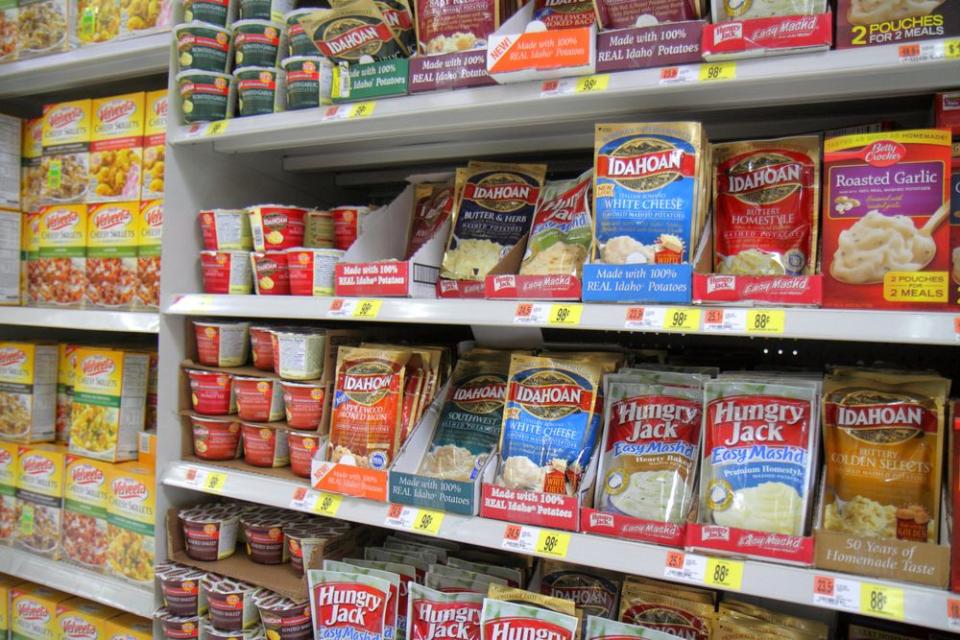The Fascinating History of Instant Potato Flakes

Few foods provide labor-saving service quite like instant potato flakes. By using this product, a cook can save time a labor usually dedicated to peeling, boiling, and mashing. The kitchen staple’s multifaceted virtues extend outside of its ability to create an instant side dish, as well; potato flakes can also be used to thicken soups and can serve as a base for sourdough starter. Instant potato flakes have become such a mainstay in many pantries that it’s difficult to imagine a time without them. And in fact, humans have been enjoying early versions of instant potatoes for centuries. But the first U.S. patent for modern instant mashed potatoes was actually filed less than 50 years ago—after food scientists finally unlocked the secret to lending instant potatoes their classic, creamy finish.
RELATED: How to Make Instant Mashed Potatoes Taste Homemade
Ages before modern food scientists created the boxed potato flakes we’re familiar with now, different cultures around the world had already discovered ways to preserve potatoes for hard times. In Peru, where more than 3,000 potato varieties are grown, the Incas created a product called chuño, according to Barbara A. Somervill’s Empire of the Incas (2004). By slicing potatoes thinly and setting them out overnight, the Incas could ensure that a portion of their crop would freeze. For several days after setting out the potatoes, the Incas would scrape ice crystals off the potato slices each morning to ensure they dried properly. Once they were freeze dried, they were placed in storage as a guard against future famines and crop failures, or to be used as rations for the military and impoverished families. Chuño was also often set out along roadsides, so that anyone journeying through the area could find a convenient meal on the road.

In Japan, the island’s indiginous people, the Ainu, also came up with a method for preserving potatoes. Indigineous Peoples’ Food Systems (2009), a work produced by the United Nations’ Centre for Indigineous Peoples’ Nutrition and Environment, explains how the Ainu people in the Saru River Region began gleaning the potatoes that Japanese farmers had left behind in the previous fall. Those frozen potatoes, which were collected in the early spring, were then soaked, mashed, and formed into balls which would be cooked over a fire or hearth. Freezing the potatoes made them sweeter, so this dish, called pene emo, was often enjoyed as a treat by children.
While these early versions of preserved potatoes provided the Incas and the Ainus with easy staples, they didn’t quickly lead to the modern version of instant potatoes we find on grocery store shelves today. Those dehydrated flakes wouldn’t come to be until the mid-twentieth century. In the early 1950s, the R.T. French Company, now known as French’s, created a product it called mashed potato granules. These flash-dried mashed potatoes became the major instant product in stores until the early 1960s, when Canadian food scientist Edward Asselbergs pioneered a different process for preserved potatoes. That method resulted in potato flakes, which soon dominated store shelves. The potato flakes broke down into hot liquid more easily, providing a smoother, richer finished product than granules. Potato granules are still carried by some companies, but Asselbergs’ invention has so far proven to be the lasting one.
WATCH: How to Make Instant Pot Mashed Potatoes
According to Gourmet Sleuth, Asselbergs created potato flakes in hopes of making foods that could be easily fortified with protein. He envisioned sending those flakes to regions where people were suffering from malnutrition. He also hoped that his invention could be used by soldiers, or even by those who might need quick foods in other scenarios, like camping. Today, instant potato flakes are a cheap, convenient comfort food, in much the same way that chuño and pene emo were for the Incas and the Ainus, respectively. And while they might not be used as much today to stave off famine, they can still round out a filling, delicious meal without breaking the bank. So the next time you spend a few bucks to stock up on potato flakes, take a few minutes to think about the centuries of work that went into this common food stuff. Even the simplest culinary ingredients sometimes requires significant time, experimentation and ingenuity to perfect.

